
In this hands-on lesson, students will be able to build an electromagnet, compare and change its variables to understand its energy.
- Subject:
- Physical Science
- Science
- Material Type:
- Lesson Plan
- Author:
- Janeen Graham
- Date Added:
- 02/26/2019

In this hands-on lesson, students will be able to build an electromagnet, compare and change its variables to understand its energy.
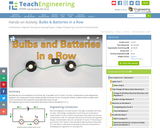
Everyday we are surrounded by circuits that use "in parallel" and "in series" circuitry. Complicated circuits designed by engineers are composed of many simpler parallel and series circuits. During this activity, students build a simple series circuit and discover the properties associated with series circuits.
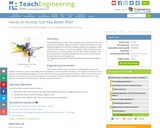
This lab demonstrates Ohm's law as students set up simple circuits each composed of a battery, lamp and resistor. Students calculate the current flowing through the circuits they create by solving linear equations. After solving for the current, I, for each set resistance value, students plot the three points on a Cartesian plane and note the line that is formed. They also see the direct correlation between the amount of current flowing through the lamp and its brightness.

In this lesson, students will investigate energy, electricity, and circuits by creating an emergency flashlight using common everyday materials. Then they will work collaboratively to design a model subdivision, creating a simple circuit to provide light to the "buildings" in their model.
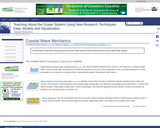
This site features Flash animations and a QuickTime movie that illustrate how waves and water molecules behave along the shore and in deep water settings. Animations depict the orbital motion of water molecules and show cross sections of waves at varying depths. These resources are suitable for use in lectures, labs, or other teaching activities.
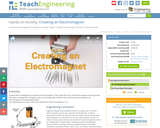
Student teams investigate the properties of electromagnets. They create their own small electromagnet and experiment with ways to change its strength to pick up more paper clips. Students learn about ways that engineers use electromagnets in everyday applications.
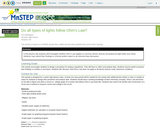
In this physics lab students will investigate whether Ohm's Law applies to common electric devices (incandescent light bulbs and LEDs). Students will design a controlled experiment, including a written procedure, and then conduct the experiment, collect and graph data. Students may submit their findings in a formal written report or through informal class discussion.

This set of problems provides students practice with calculations dealing with electric circuits. Each problem features an audio clip describing the solution process. 34 problems in the set

This brief video lesson discusses the physics of electrical phenomena by looking at the history of the major vocabulary terms associated with electricity such as electron, battery, charge, and current. Discussion/assessment questions and suggested supplemental resources are included.

In this activity, students use the provided table to organize information about the average monthly time usage and energy consumption for all electrical appliances in their home. Upon collecting data and calculating costs, they draw conclusions regarding the types of appliances which are the biggest consumers of electrical energy. Teachers will need to supply the average cost of a kiloWatt-hour for the local area. Students will create a complete lab write-up at the conclusion of the activity.

Students learn about the Foucault pendulum an engineering tool used to demonstrate and measure the Earth's rotation. Student groups create small experimental versions, each comprised of a pendulum and a video camera mounted on a rotating platform actuated by a LEGO MINDSTORMS(TM) NXT motor. When the platform is fixed, the pendulum motion forms a line, as observed in the recorded video. When the rotating, the pendulum's motion is observed as a set of spirals with a common center. Observing the patterns that the pendulum bob makes when the platform is rotating provides insight as to how a full-size Foucault pendulum operates. It helps students understand some of the physical phenomena induced by the Earth's rotation, as well as the tricky concept of how the perception of movement varies, depending on one's frame of reference.

Using plastic straws, wire, batteries and iron nails, student teams build and test two versions of electromagnets one with and one without an iron nail at its core. They test each magnet's ability pick up loose staples, which reveals the importance of an iron core to the magnet's strength. Students also learn about the prevalence and importance of electromagnets in their everyday lives.
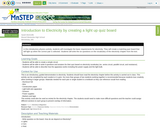
In this introductory physics activity, students will investigate the basic requirements for electricity. They will create a simple circuit for a quiz board that will light up when the correct matching pair is selected. Students will create six questions and answers for the quiz board, using electricity vocabulary terms.
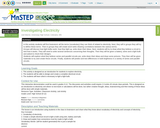
In this activity students will first brainstorm all the terms (vocabulary) they can think of related to electricity. Next, they will work collaboratively in groups to try to define these terms. Then in groups they will create word webs drawing correlations between the various terms. Groups will discuss how light bulbs work, how they light up, write down their ideas. Next, students will try to draw what they believe a circuit is and how it works. They will need to write several sentences concerning their thoughts. Then they will be given a battery, wires and a light bulb and asked to check their designs. Students will explore what they believe series and parallel circuits are, write down their ideas and draw some pictures. They then will be given materials to try and create these circuits. Finally, students will predict and test differences in bulb brightness in a variety of series and parallel circuits.
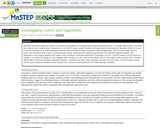
In this lesson, students will build a simple DC motor out of metal coat hangers, a 24-guage wire armature and field magnet, 14-guage wire brushes, and build the motor so that it rotates when connected to a 10-volt DC power supply. Students will understand the principles of operation of the DC motor, to include: induction of an electromagnetic field via current flowing through a conductor (electromagnetism), and become familiar with the notion that Forcetotal of the motor is proportional to charge, proportional to speed, proportional to the induced magnetic field (B), and dependent on the angles between the rotation of the armature in the field magnetism. Forcetotal = qv X B = (mv2/R), where q is the amount of charge, v is velocity of charge, B is the magnetic field strength, m is the mass of the charge, and R is the radius of the armature loop. Students will be able to solve one variable magnetism problems, describe how their motors operate, and write up a lab report on their findings. During the lab report, students will discuss how they got their motors to rotate faster than the initial trial after building it.
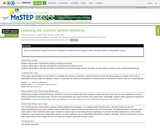
In this advanced physics lesson, students will review electricity and circuitry concepts through a Power Point presentation and then dissect a disposable camera to investigate the internal circuit structure.

This worksheet provides students practice with calculations involving electrical circuits such as electric potential, resistance, power, and energy.
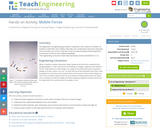
The application of engineering principles is explored in the creation of mobiles. As students create their own mobiles, they take into consideration the forces of gravity and convection air currents. They learn how an understanding of balancing forces is important in both art and engineering design.
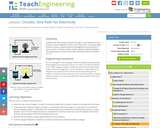
Students learn that charge movement through a circuit depends on the resistance and arrangement of the circuit components. In a hands-on activity, students build and investigate the characteristics of series circuits. In another activity, students design and build a flashlight.

Background: students are familiar with static electricity, charge, and sparks. They also know about conservation of energy, forms of energy including potential energy, power, and work. Students will complete a variety of activities using breadboards, which will display various types of circuits and their effect on the flow of electricity.